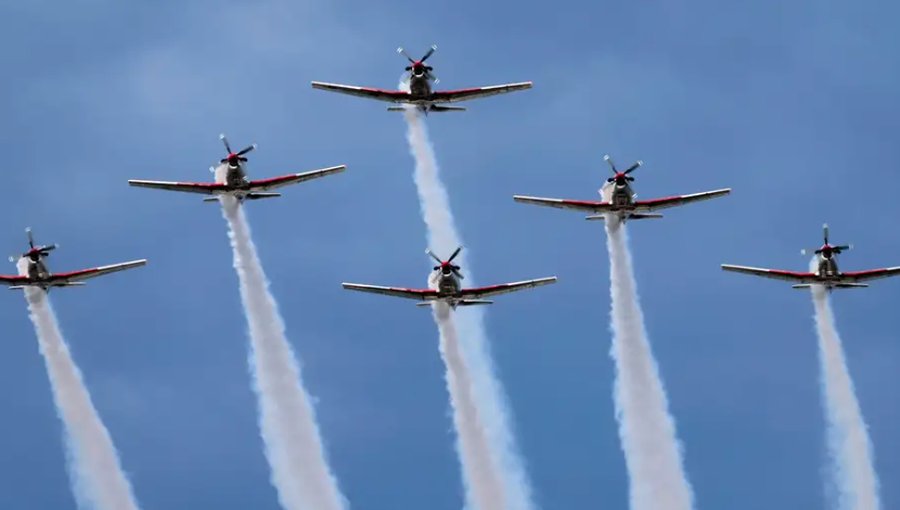
The competitive nature of the arms race between Serbia and Croatia: are the military parades of Zagreb and Belgrade just propaganda?
Croatia organized its military parade on the occasion of the 30th anniversary of Operation Storm (Oluja) on Thursday, July 31. Belgrade, on the other hand, is preparing its parade for September 20.
The response to a parade with a parade is just another continuation of the long-running arms race between Serbia and Croatia. Serbian President Aleksandar Vučić links almost every arms purchase to Croatia and its weapons. He has often proclaimed Serbia to be "the strongest military power in the region."
But while the military parade in Belgrade is expected, as a kind of overture to the promotion of new officers, which is scheduled for Saturday, August 2, 2025, it is already being heavily criticized in advance.
For critics of the regime, the fact that due to the so-called "Ćaciland" (as the place where Vučić's supporters gather in Belgrade) in the center of Belgrade, the promotion was moved to the barracks in Banjica, shows the current government's lack of respect for the Serbian Army. Such humiliation of the Army is seen as a message that "Ćaciland" is more important to Vučić than the country's armed forces.
The generation of intolerance
"There is no doubt that Serbia and Croatia are competing to modernize their armed forces. Croatia is in NATO, but it still sees Serbia as the biggest security challenge. Serbia also sees Croatia in the same way," military analyst Aleksandar Radic tells DW.
"We cannot reduce relations between Serbs and Croats only to military parades and weapons. In a way it is surprising that 30 years after Operation Storm so much intolerance is being created. After that tragic event Serbs are no longer important in Croatia in terms of their numbers and role. But Belgrade and Zagreb have clearly found a way to continue generating hatred and intolerance," Radic told DW.
Parade or masquerade?
"I call these parades a farce that only serves the domestic public," journalist Davor Lukac tells DW. "Croatia, as a NATO member, is not threatened by Serbia. The military parades we are talking about only serve to boost morale and propaganda, because they are trying to show the power of their weapons, which they otherwise cannot use against anyone in the region."
Although some analysts believe that the Croatian military parade is a message to Belgrade, Aleksandar Radic believes "that this rivalry is not the motive for holding the parade."
"Croatia attaches great importance to the commemoration of Operation Storm, so it was expected that something like this would be organized. But now we have a Serbian parade and the question arises as to what is the motive for organizing it? No matter how much Vučić tries to present it as a show of strength towards Croatia, this parade has much more to do with his internal problems and protests. The date of September 20th has no significance for Serbia, there is no reason for this parade and we can say that it was organized to show rebellious Serbia that 'I am stronger than you'. This is how he will declare victory over the color revolution," Radić emphasizes.
Serbia is still in the second league
As a significant moment in this regional arms race, Aleksandar Radić also highlights Croatia's membership in NATO, which "gives it the opportunity to purchase various types of weapons, according to modern specifications, which are not available to Serbia. This is why Serbia now has a mix of Russian, Chinese, French weapons and all the limitations that such a diverse range brings. NATO military training should also be mentioned - there is some cooperation, but it is unlikely that NATO will allow Serbia access to all the nuances of modern training according to NATO standards", Radić draws attention.
Who supports the "color revolution"?
During the months of protests in Serbia, Croatia was identified as a key country supporting the so-called "color revolution." Later, several other Western countries and secret services were blamed, but it is not known whether there are actually countries and secret services involved in the protests.
Croatia thus remained the only country publicly named, while unidentified Western countries remained part of the tabloid pack spreading anti-Western rhetoric in Serbia.
"This is important for the regime and Vucic, because there are still many refugees from Krajina in Serbia," says Lukac, adding that "voters here still believe, even though it is absolutely impossible, that a war with Croatia is possible."
"The government is constantly pushing this. For thirty years, the trauma of the war in Croatia has been used to maintain tensions in both Serbia and Croatia," Lukac notes.
A similar assessment is made by Aleksandar Radic, who says that "Vučić is sending messages to Serbs from Krajina who are important voters and who have the trauma of Operation Storm, as well as to nationalist circles who have a sense of revanchism towards Croatia."
According to him, this is no coincidence. "It is an unpleasant situation for the government. The majority in Serbia believes that foreign intelligence services are destroying Serbia, but the government, of course, will never say that it is some Western country, because that is not very appropriate and smart. So that leaves only Croatia," concludes Radić./ DW (A2 Televizion)











